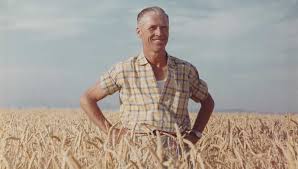
Norman
In the mid-20th century, as global population growth threatened to outpace food production, one man’s innovative work prevented widespread famine and saved millions of lives. This often-overlooked hero is Norman Borlaug, an American agricultural scientist who led the Green Revolution during the 1960s. By developing and distributing high-yield, disease-resistant varieties of wheat, Borlaug not only boosted global food production but also helped millions combat hunger. Today, with the world population surpassing seven billion, Borlaug’s legacy continues to underscore the critical importance of agricultural innovation in ensuring global food security.
The roots of this remarkable journey trace back to March 25, 1914, when Norman Borlaug was born in Cresco, Iowa. Borlaug’s family, Norwegian immigrants, managed a farm in a small Norwegian-American community. Despite their limited formal education, Borlaug’s parents valued learning and instilled in him a strong work ethic. As a child, Borlaug often walked several miles to attend a one-room schoolhouse, an early display of his determination. His experiences on the family farm, coupled with the hardships of the Great Depression, shaped his understanding of agriculture and food security. Despite financial difficulties typical of the era, Borlaug’s family continued to support his aspirations. Driven by a desire to make a difference, Borlaug made the pivotal decision to leave the farm and pursue his undergraduate studies at the University of Minnesota in 1933.
Unable to immediately begin college due to financial constraints, Borlaug took a gap year to earn money for his education. He joined the Civilian Conservation Corps (CCC), a New Deal program designed to provide jobs for young men during the Great Depression. This choice not only offered employment but also aligned with Borlaug’s growing interest in environmental sustainability. His primary tasks included planting trees to reforest areas depleted by logging and combating soil erosion through terrace construction, which provided Borlaug with practical experiences in land management and conservation. During this time, Borlaug was struck by the realization that many of the unemployed workers alongside him were struggling with hunger, awakening him to the urgent need for improved food security. Overall, this experience not only contributed to restoring local ecosystems but also laid a crucial foundation for Borlaug’s future work in sustainable agricultural practices.
Building on his CCC experience, Borlaug resumed his studies at the University of Minnesota in 1935, initially pursuing a degree in forestry. After earning his bachelor’s in 1937, his growing interest in plant diseases and their impact on food production led him to shift his focus to plant pathology and genetics. Returning to his alma mater for graduate studies, Borlaug researched the interaction between plants and pathogens. His master’s work, completed in 1940, explored how environmental factors influenced plants’ susceptibility to fungal infections. Borlaug’s passion for this field drove him to pursue doctoral studies, where he further honed his expertise in plant breeding. He crossbred plants to study the inheritance of disease resistance and analyzed the offspring to identify genetic combinations that offered stronger defenses against diseases. This experience proved crucial in developing his approach to creating more resilient crops. In 1942, Borlaug completed his Ph.D. with a dissertation titled “Variation and Variability in Fusarium Lini,” which explored the genetics of disease resistance in flax crops. This work laid the groundwork for his future breakthroughs in developing disease-resistant wheat varieties, foreshadowing the revolutionary impact he would soon have on global agriculture.
Unfortunately, this promising line of research was abruptly interrupted by world events. The attack on Pearl Harbor on December 7, 1941, ignited a strong sense of patriotism in many Americans, including Borlaug. Despite his recent academic achievements, he attempted to enlist in the military but was rejected due to wartime labor regulations. Instead, his expertise was redirected to support the war effort, with his laboratory repurposed to conduct research for the United States armed forces. One of Borlaug’s first military research projects involved developing a glue that could withstand the warm saltwater of the South Pacific. Within weeks, Borlaug and his colleagues had developed an adhesive that resisted corrosion in tropical conditions. This innovation allowed food and supplies to reach the stranded Marines without being compromised by harsh environmental conditions.
After World War II, Borlaug redirected his focus from wartime research to his true passion: agricultural innovation. This passion propelled him towards a new frontier—Mexico. In 1944, impressed by Borlaug’s exceptional talent and dedication, the Rockefeller Foundation offered him a unique opportunity to lead their Cooperative Wheat Research and Production Program in Mexico. This was not a return to traditional academic research; it was a mission to address a critical real-world problem. At the time, Mexico was grappling with a severe wheat shortage, approaching the brink of famine. Borlaug’s task was nothing less than revolutionary: to develop high-yielding, disease-resistant wheat varieties specifically tailored to Mexico’s diverse climate. The stakes were incredibly high, yet Borlaug, fueled by a relentless determination, eagerly accepted the challenge.
Borlaug wasted no time in establishing research stations across Mexico, strategically chosen to represent the country’s varied ecological zones. While conventional breeding typically produced only one generation per year, Borlaug pioneered the use of “shuttle breeding”—a technique that took advantage of Mexico’s unique geography to grow multiple generations of wheat per year. Winters were spent planting and harvesting crops in the warm southern regions, while summers were dedicated to the same in the cooler northern areas. This relentless cycle dramatically accelerated the breeding process, allowing Borlaug and his team to test and refine new wheat varieties at an unprecedented pace.
Within a few years, Borlaug and his team developed semi-dwarf, high-yielding wheat varieties that were remarkably resistant to the devastating stem rust disease, which had long plagued Mexican crops. This breakthrough dramatically transformed Mexico’s agricultural landscape, turning the country from a wheat importer to a net exporter within two decades. However, Borlaug’s impact extended far beyond these innovative breeding techniques. He recognized the critical role of collaboration and knowledge transfer in creating lasting change. Working closely with Mexican scientists, Borlaug not only ensured the program’s immediate success but also invested in the future by training a new generation of agricultural researchers and fostering a spirit of self-sufficiency in Mexico. This holistic strategy laid the groundwork for the Green Revolution, a global agricultural movement that would help alleviate hunger and malnutrition worldwide.
Building upon his success in Mexico, Borlaug turned his attention to South Asia in the 1960s, where countries like India and Pakistan faced critical agricultural challenges due to rapidly growing populations. Applying the lessons learned in Mexico, Borlaug introduced high-yielding wheat varieties that carefully adapted to the region’s unique agro-ecological conditions, offering a beacon of hope. His approach went beyond simply introducing new crop varieties; he emphasized improved farming practices, farmer education, and collaboration with local institutions, fostering a transformative shift in agricultural practices. The resulting surge in wheat production led to a dramatic increase in food availability, ensuring nationwide food security. This agricultural renaissance revitalized rural economies and contributed significantly to overall economic growth, leaving an enduring legacy of prosperity.
Following his groundbreaking work in Asia, Borlaug expanded his influence to Africa in the 1980s. However, his efforts faced an unexpected hurdle. Environmental groups, concerned about the ecological impact of intensive farming methods, particularly the heavy use of chemical fertilizers, pressured donor countries and foundations to withdraw funding for Borlaug’s African projects. This opposition significantly hampered his initial plans for widespread implementation across the continent. Undeterred, Borlaug found a new avenue for his work. In 1986, he partnered with the Sasakawa Africa Association (SAA) and the Carter Center’s Global 2000 program. Through this collaboration, he began introducing his high-yielding crop varieties and improved agricultural practices in select African countries.
This approach showed promise, with participating farmers in Ghana and Sudan experiencing up to threefold increases in maize yields. Nevertheless, Africa presented Borlaug with a whole new set of agricultural hurdles. Unlike Asia with its established irrigation systems, much of Africa relied on rain-fed agriculture, making crops vulnerable to droughts. The continent’s diverse farming practices and limited infrastructure also posed significant obstacles to widespread implementation of his methods. Despite these challenges, continuous efforts by the SAA led to significant improvements in food production across different parts of sub-Saharan Africa. Today, Borlaug’s legacy in Africa is carried forward by the SAA, which continues to work with farmers, researchers, and governments to enhance agricultural productivity and food security.
Even in the twilight of his career, Borlaug remained deeply concerned about future global food security. With a keen eye on demographic trends, he grappled with the challenge of feeding a burgeoning population on a finite amount of arable land. His calculations were stark: by 2050, we’d need to double food production, with most increases coming from existing agricultural lands. This sobering reality fueled his fervent advocacy for scientific advancements to drastically increase crop yields. Borlaug saw genetically modified organisms (GMOs) as a vital tool in this effort against hunger. He dismissed concerns about GMOs being inherently unnatural, arguing that they were simply an extension of the selective breeding practices used for millennia. In his view, GMOs held the potential to combat large-scale crop diseases and create more resilient plants.
Borlaug’s approach to global food security was far from one-dimensional. Throughout his career, he consistently stressed the critical role of access to and acceptance of new agricultural methods. His continued affiliation with population control organizations like the Population Media Center, even in his later years, hints at a more nuanced perspective. Ultimately, Borlaug’s legacy suggests a belief that ensuring global food security required a two-pronged approach: one that simultaneously focused on agricultural advancements and responsible population management. This holistic vision underscores the depth of Borlaug’s thinking and the enduring relevance of his work in addressing one of humanity’s most pressing challenges.
By: Yoon Woo Chyung
Write and Win: Participate in Creative writing Contest & International Essay Contest and win fabulous prizes.


